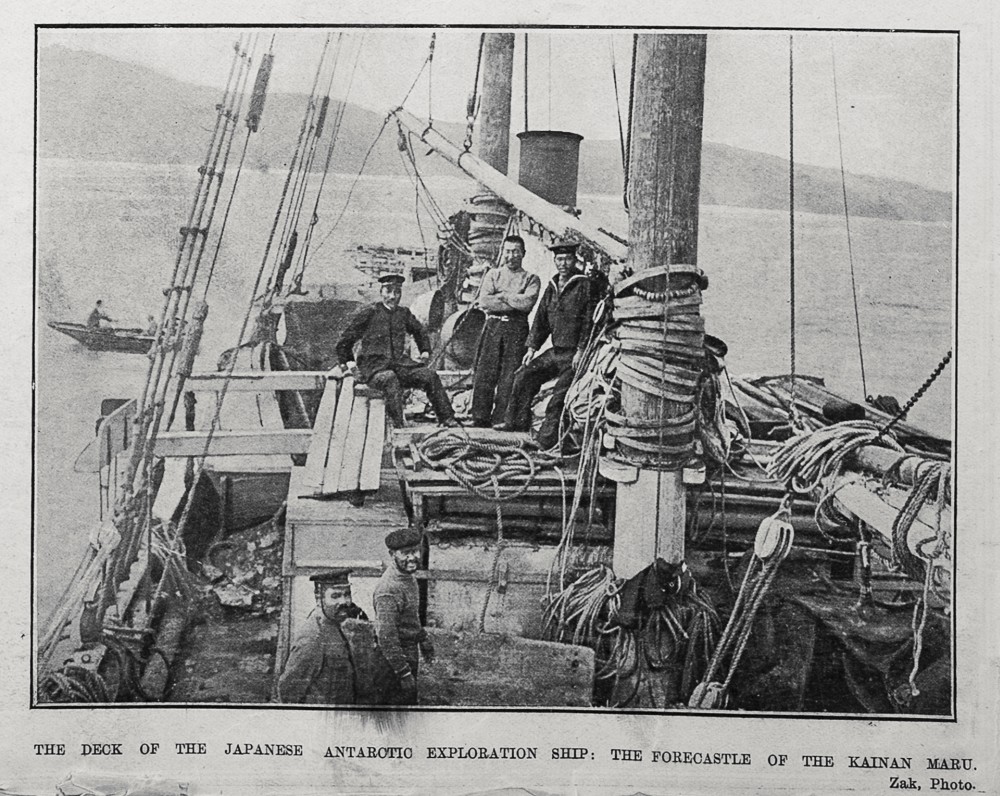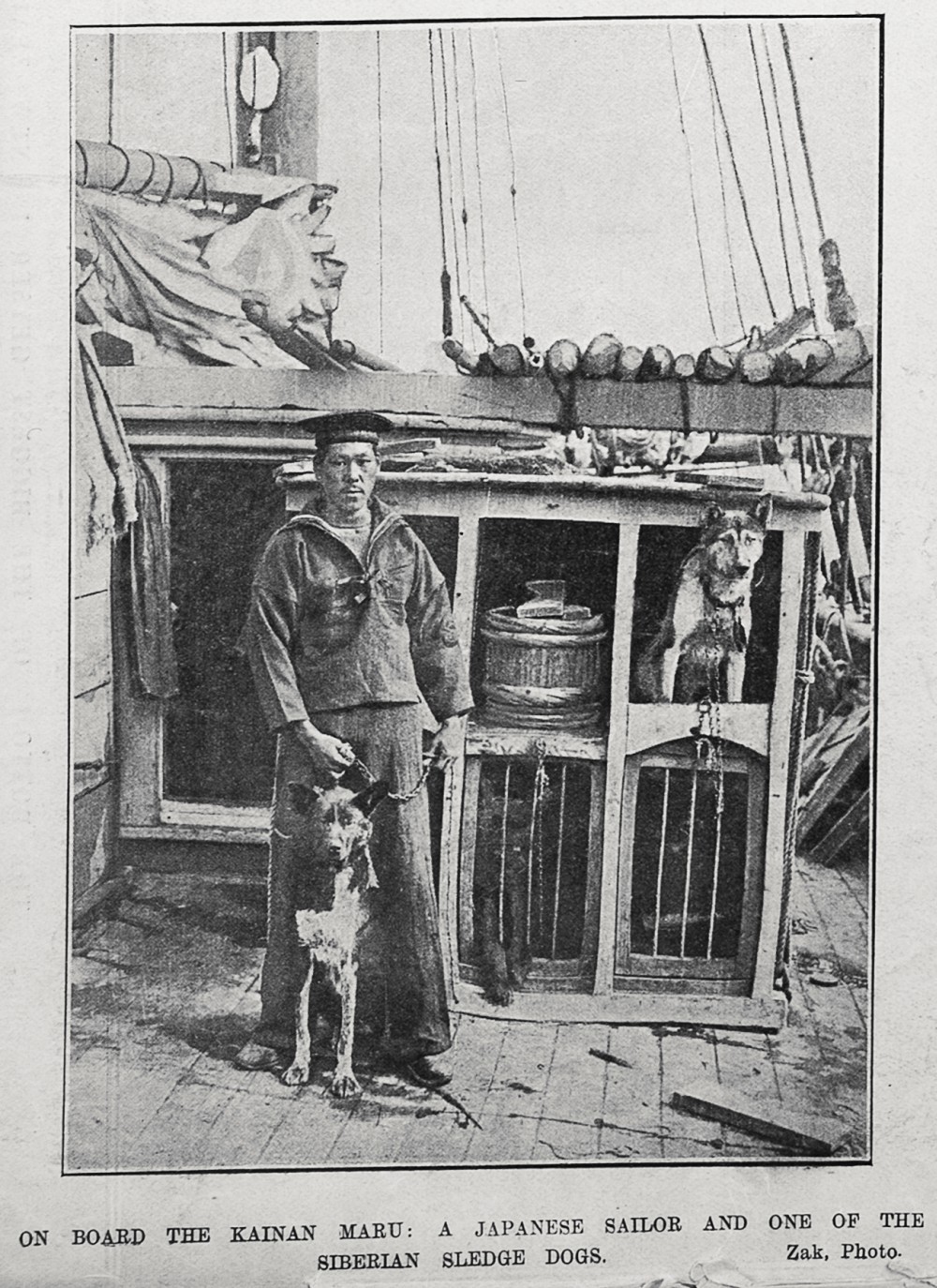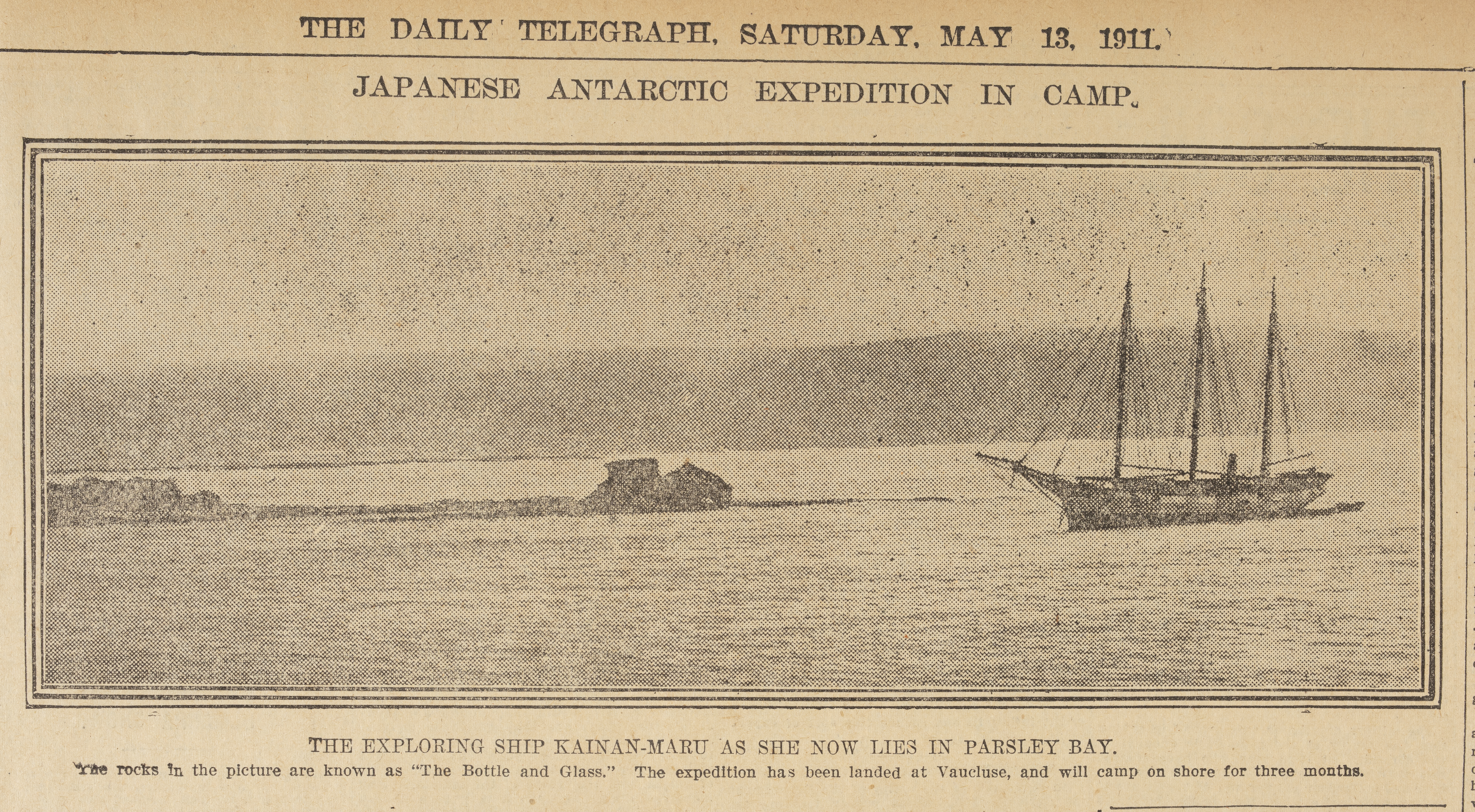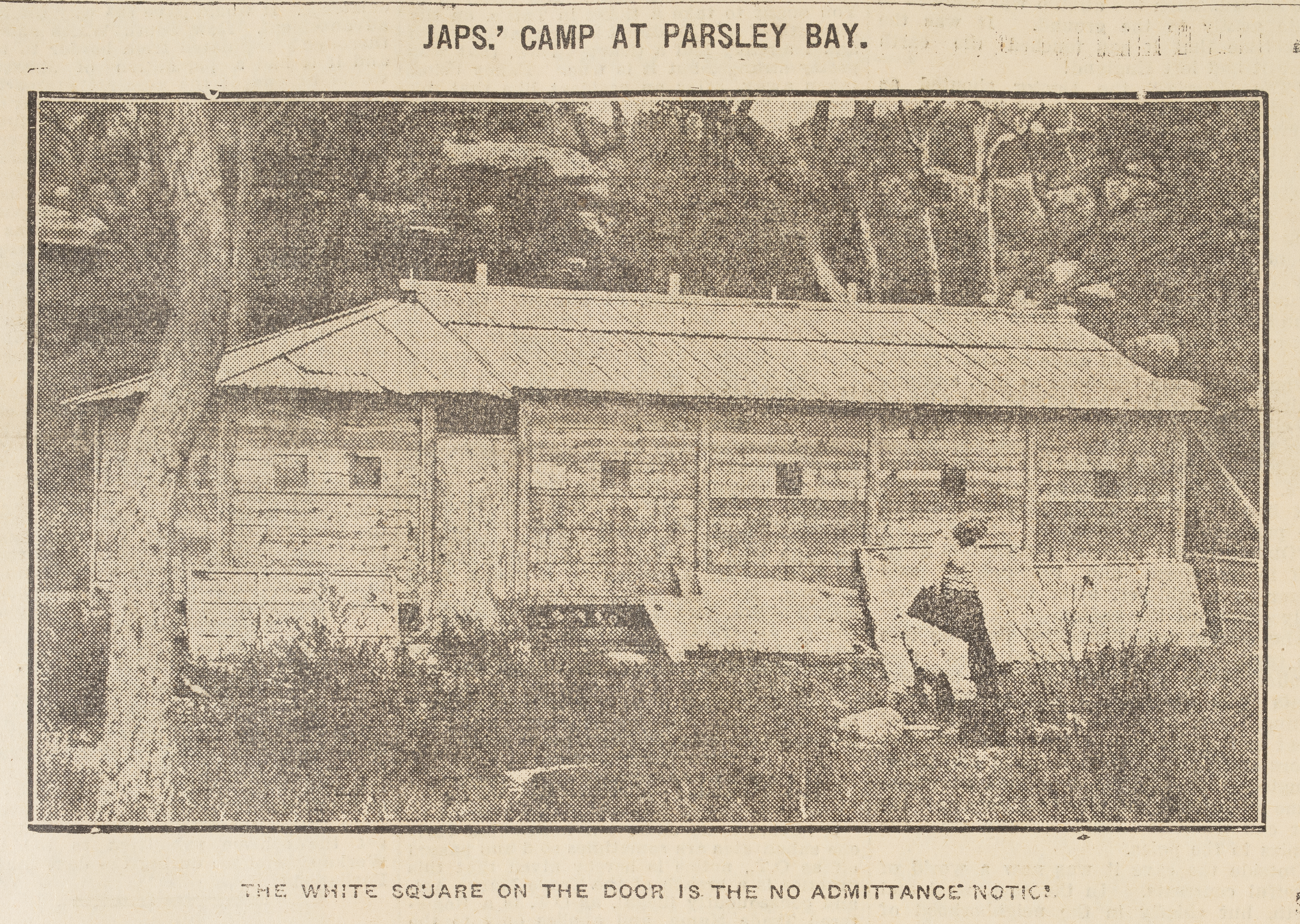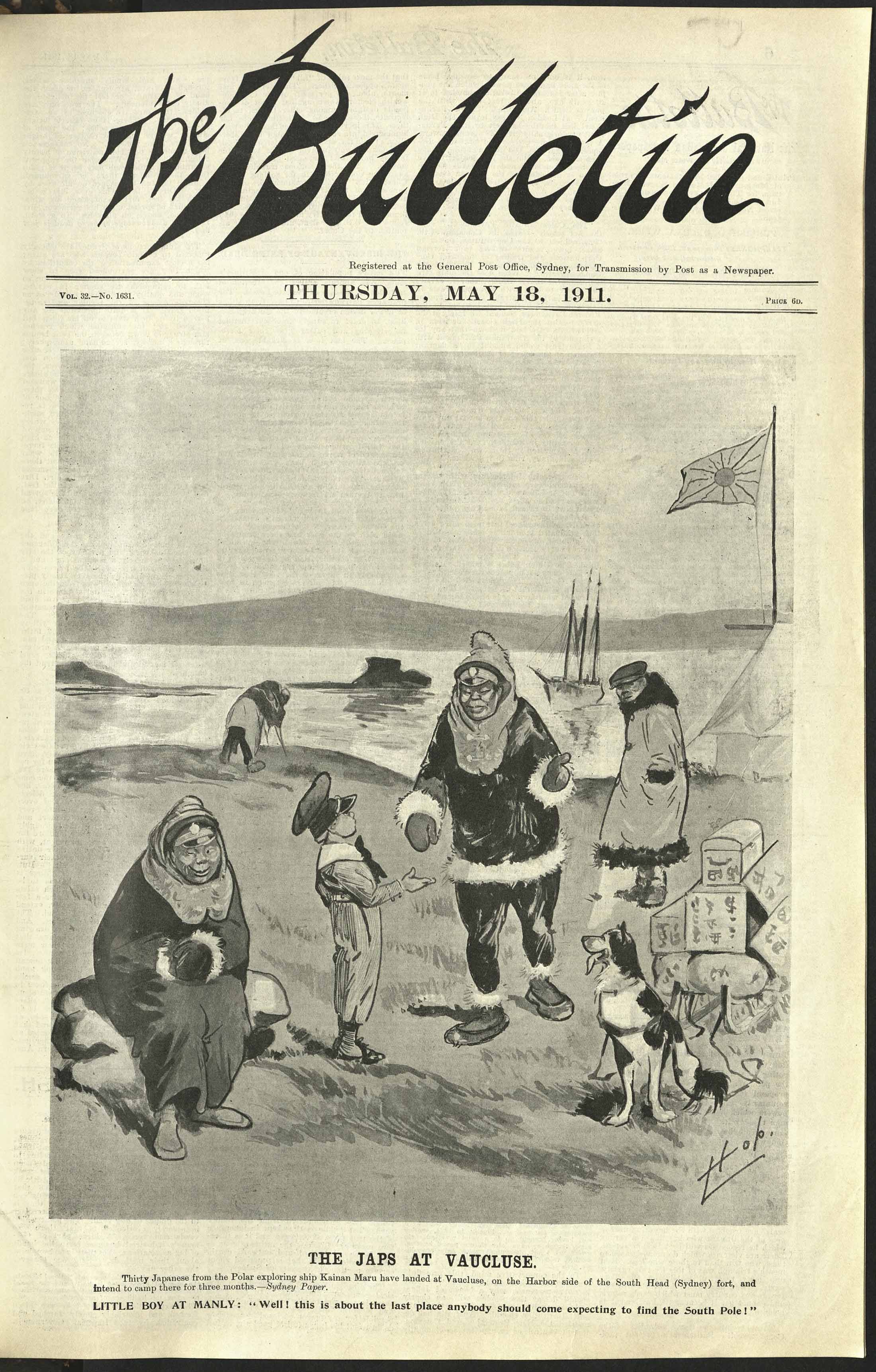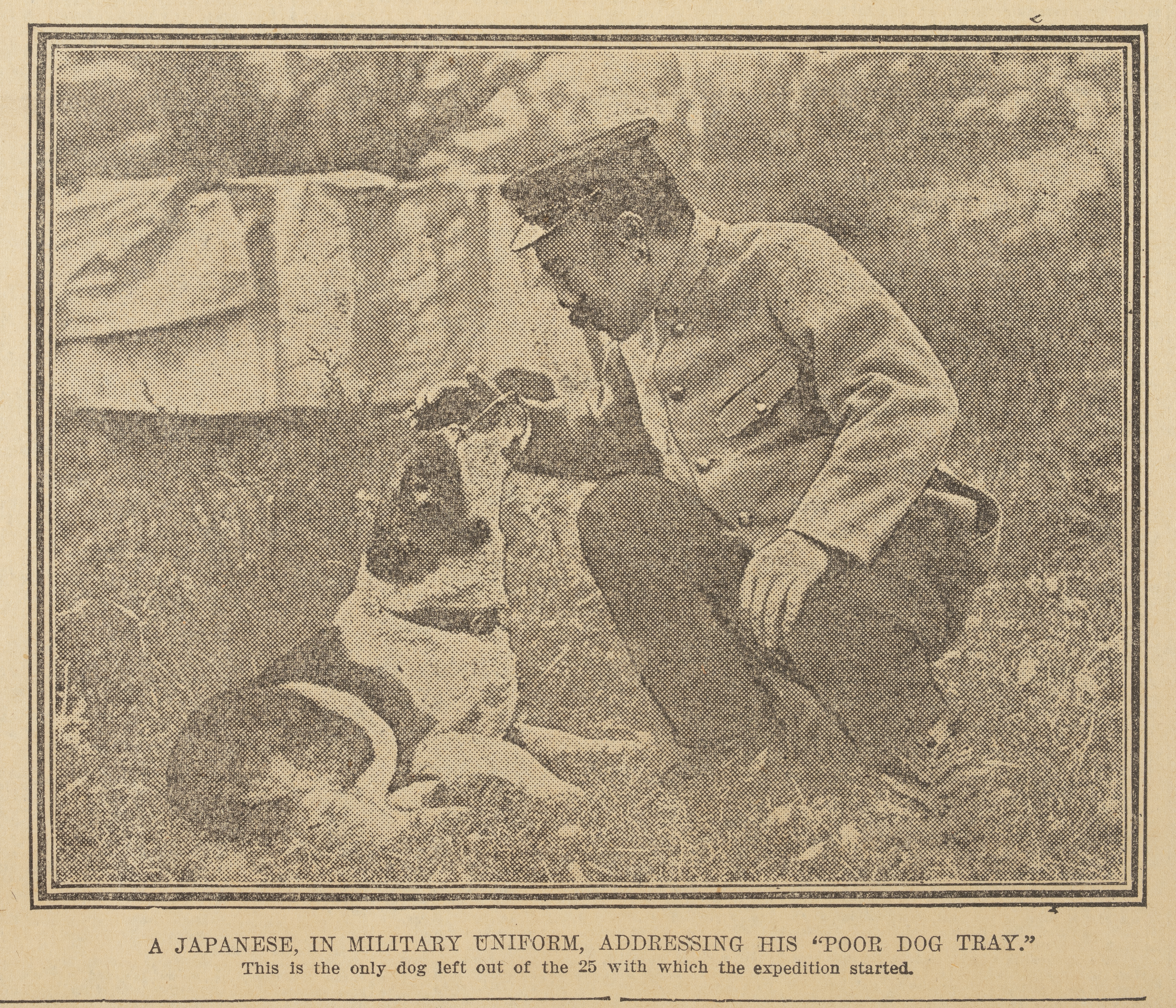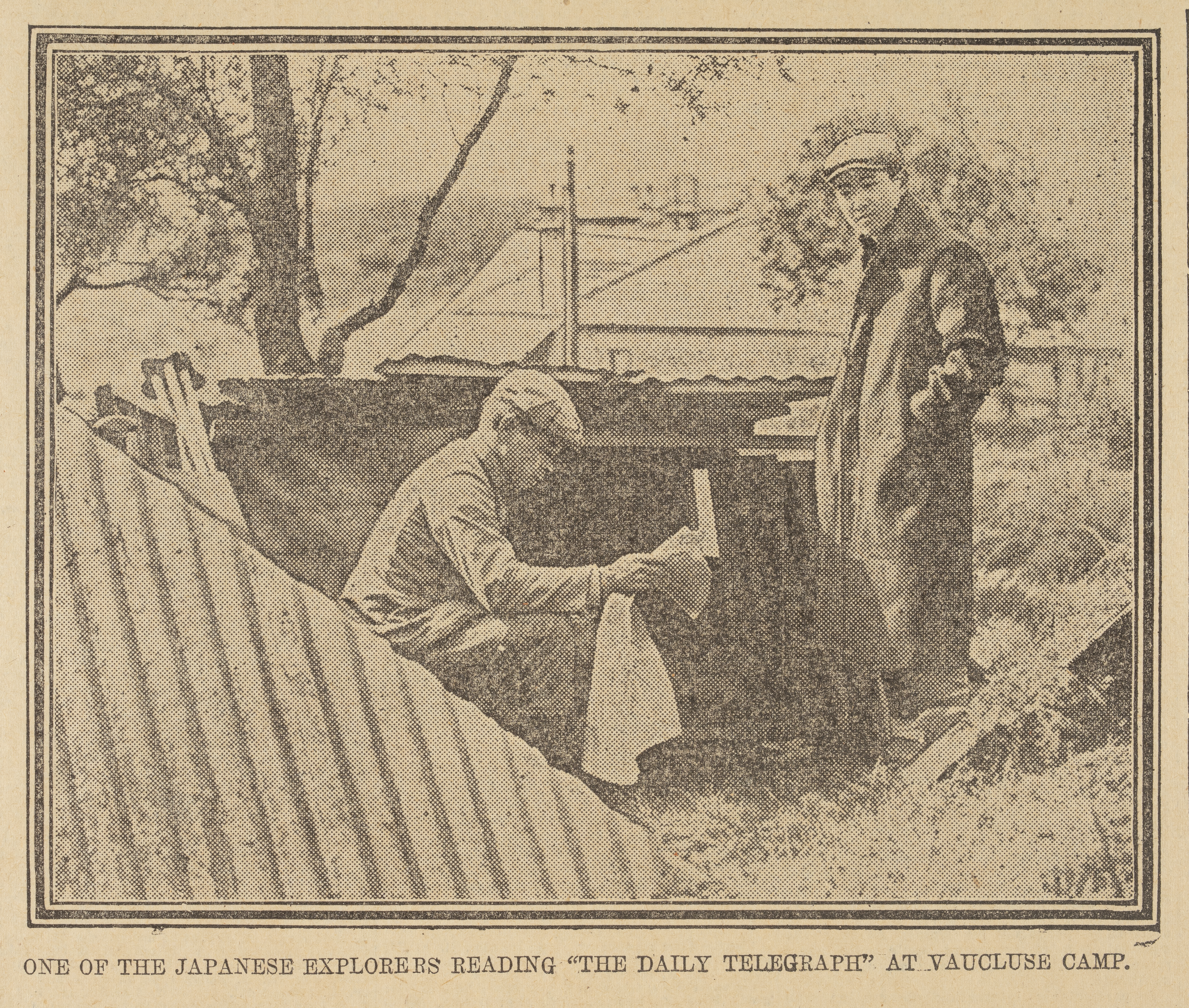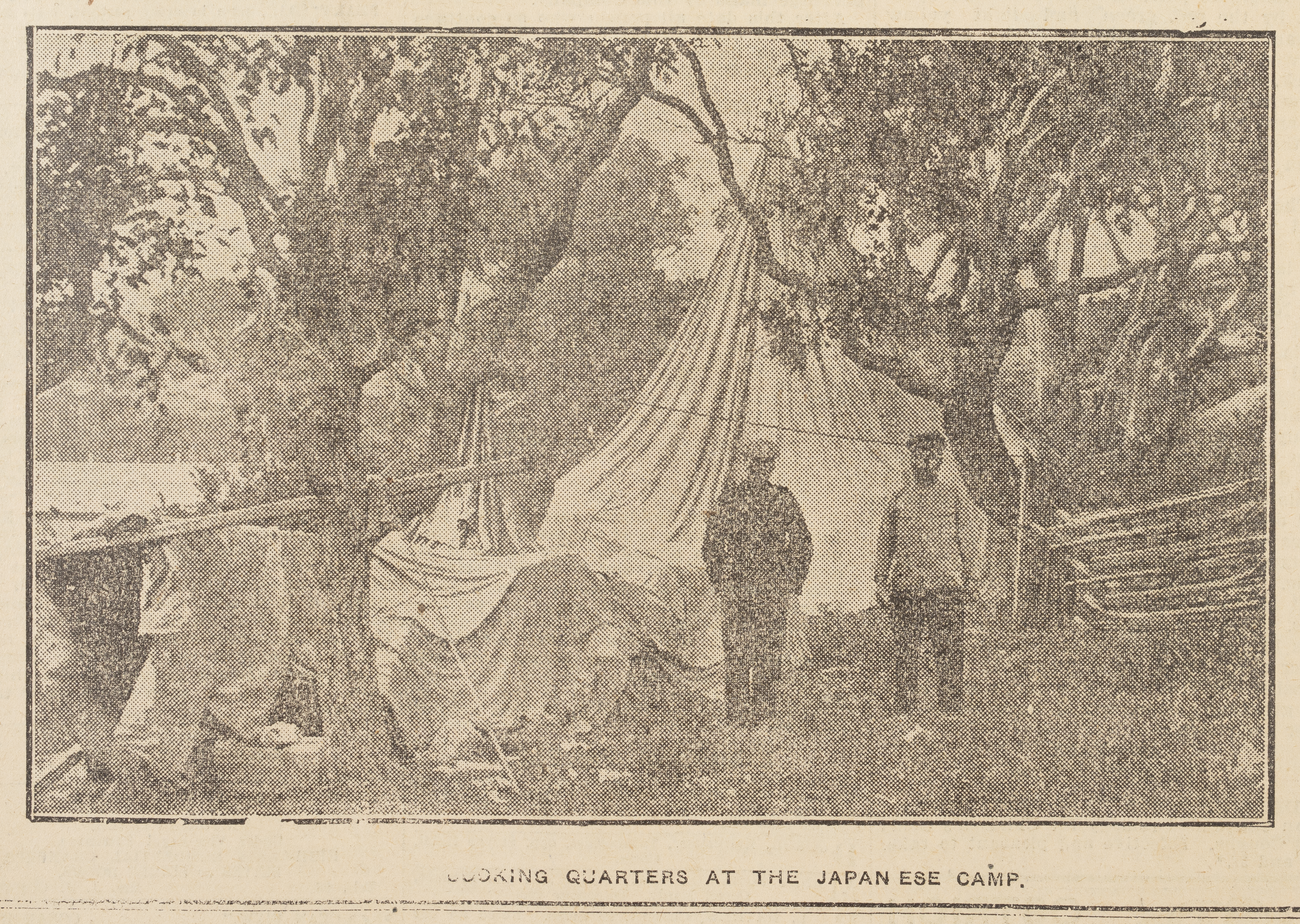The Dictionary of Sydney was archived in 2021.
Japanese Antarctic expedition camp at Parsley Bay 1911
Citation
Persistent URL for this entry
To cite this entry in text
To cite this entry in a Wikipedia footnote citation
To cite this entry as a Wikipedia External link
The Japanese Antarctic expedition camp at Parsley Bay 1911
The Expedition
[media]On 29 November 1910, a Japanese expedition bound for the Antarctic left Tokyo’s Shibaura Harbour, farewelled by a crowd of over 50,000 people. Led by Lieutenant Nobu Shirase and funded largely by donations, the original goal of the 27 member team had been to be the first men to reach the South Pole.
[media]They were however in competition with the Norwegian polar explorer Roald Amundsen and the British expedition led by Robert Scott, and when it became clear that they would not reach the South Pole in time, the expedition changed its focus to purely scientific research.[1]
The expedition’s ship, Kainan Maru (the ‘Opener-up of the South’) was a 204 ton (185 tonne), 100 foot (30 metre) long converted wooden fishing boat with an 18-horse-power auxiliary engine captained by Naokichi Nomura.[2] The expedition had left later in the year than originally planned, and there were concerns that the expedition was inadequately prepared for the conditions.
[media]On 8 February the ship sailed into Wellington, New Zealand, by which time about half of the 27 sled dogs they had taken with them had already died.[3]
In early March the Kainan Maru reached the Antarctic Circle but despite being able to see the mainland, the Antarctic winter was setting in, and the poor weather and increasing formation of ice meant it was impossible to land. The vessel was forced to retreat.[4]. After a rough passage, the Kainan Maru entered Sydney Harbour at 4pm on 1 May 1911 and anchored at Double Bay.[5]
Parsley Bay
[media]The Kainan Maru was initially permitted to moor in Parsley Bay but moved back to Double Bay before undergoing repairs in Jubilee Dock, Balmain.[6] While most of the crew initially stayed on board their ship (the ship’s captain Nomura and another officer returned to Japan to raise additional funds), as per the restrictions of the Australian Immigration Restriction Act, scientists from the East were permitted by the same act to enter the country and live ashore, provided this did not exceed six months. Although the Australian government wanted them to stay at the Hotel Australia the expedition budget would not allow for this.[7]
[media]Instead Fitzwilliam Wentworth, with the Vaucluse Council's hesitant approval, made space available for the scientists not far from the Wentworth Mausoleum on the Vaucluse estate. After some initial confusion as to which side of the estate was intended, the Japanese explorers quickly erected a demountable wooden hut and canvas tents at Parsley Bay and established their camp.[8]
Accordingly this section of the expedition set about erecting shore quarters and in a remarkably brief space of time had a light wooden structure of pine erected on a gently sloping piece of land lent to the by the trustees of the Wentworth Estate. Their home is picturesquely situated, nestling among trees and shrubs at the base of a small bluff; it lies well sheltered from the weather, and makes an ideal camping site. A trench about 18 inches deep has been cut triangularly round the building and takes away all soakage from the hill at the rear. Strong brush fences have been made round the quarters, electric bells fitted to the improvised gates, neat pathways formed round the house and an ingenious modern archway made at the front entrance to their domain while the Flag of Japan flutters from a pole fastened to a tree in the centre of the ground they occupy.[9]
By coincidence, only months prior to the arrival of the Shirase party, a kiosk had been built at Parsley Bay in a Japanese teahouse style.[10]
Suspicious minds
Recent Japanese military victories in the Sino-Japanese War and the Russo-Japanese War had fuelled fears that Japan had entered a period of national expansionism, and prior to the arrival of the Kainan Maru there had been articles in Australian papers such as ‘The Japanese Menace’ and ‘The Japanese Scare‘[12]. Even though no evidence or suggestion of spying could be found, the Royal Australian Artillery quietly installed guards at the South Head forts and other sensitive areas in the days after the expedition’s arrival; some deemed these suspicions as 'worse than inhospitable-it is sheer nervous stupidity'. Shirose told Jeanne di Czaykowska, a 'Polish lady journalist' who interviewed them for Sydney newspaper The Sun that there was no secrecy or underhanded intent:
their visit to the Antarctic had convinced them that their action had been premature, and they bowed to inevitable... he would remain Sydney, acquiring knowledge of the most effective method of mastering Polar lore until the time came for another attempt.[13]
Professor Edgeworth David, a geologist at the University of Sydney and eminent public figure who had been part of the British Nimrod expedition to the Antarctic in 1907-1909 was impressed by the Japanese achievements and spoke publicly in the expedition's defense, describing them as a ‘gallant band of men’. He developed a strong friendship with Shirase and shared his experiences and knowledge of the region with the expedition team. [14] His public support meant not only that the members of the Japanese expedition were accepted in Sydney more warmly than they might have been otherwise, but also ensured they had enough supplies, scientific apparatus and research materials.
Local life
[media]As the company increasingly became part of the local community, suspicions and prejudice subsided. As well as the members of Sydney's small Japanese community, hundreds of other curious Sydneysiders visited the camp, although the mutual inability to speak each other’s languages left many questions unanswered. Children wandered about the camp and were given souvenirs like Japanese newspapers or sweets. The children also taught the visitors popular songs in English, like 'Yip-I-addy-I-ay'.
[media]The Japanese explorers themselves, when not improving their camp or reading the many books they had with them, spent much of their time fishing in the harbour waters in a small skiff. Only one of the sled dogs had survived the voyage, but it remained with them in the camp.
If all the citizens of Vaucluse behaved themselves as well, and obeyed sanitary instructions as carefully as these men had done, the suburb would be a very beautiful one.[15]
The coronation of King George V in England on 22 June 1911 was celebrated throughout Australia, and the Japanese party at Parsley Bay also participated enthusiastically, decorating their camp with bunting and flags and presenting 'a very artistic and holiday-like appearance'. Entwined Japanese and British flags were handed out to children and a service, facing England, was carried out in Japanese congratulating the new King and Queen. Most of Sydney’s Japanese community also attended, including the Chancellor of the Consulate Mr Hayashi.
Visitors were entertained with a wrestling and ju-jitsu display, a traditional temple play, singing and Japanese food. The Sun reported:
A table which contained Japanese dishes (mainly vegetables - carrots, French beans, and potatoes - cooked in national fashion), was set out for the visitors. There were sweetmeats and Japanese biscuits in profusion.
After the display, which lasted well over two hours, Alderman Dr. George Read thanked the Japanese for the interesting and clever exhibition of their national sports and pastimes, and called for three cheers for the Mikado. These were loudly given.[16]
Departure
On 15 November 2011 the Japanese mail steamer Kumano Maru arrived in Sydney, carrying three more men who were to join the expedition, supplies and 29 dogs for the expedition. One of the new arrivals, Yasunao Taizumi, was a cameraman or 'biograph operator', there to document the expedition on film.
[media]The Kainan Maru set sail through the heads, bound again for Antarctica, on Sunday 19 November 1911.[17] Professor Edgeworth David and other visitors had gone onboard to wish the expedition success and went ashore at Shark Island [18] but prior to their departure, Lieutenant Shirase presented Professor Edgeworth David with his 17th century Japanese samurai sword, thanking him for his support. The sword is now in the Australian Museum. [19]
The expedition reached their furthest point south of 80° 5 in Antarctica on 28 January 1912.[20] The expedition returned, via Wellington and a side trip to Sydney,[21] to a hero’s welcome in Tokyo on 20 June 1912.
There is little sign of the Japanese camp in Parsley Bay now. In March 2002 Woollahra Council unveiled a memorial plaque at Parsley Bay to commemorate the expedition. A playground ship there bears the name of the Kainan Maru.
References
Ivar Hamre, ‘The Japanese South Polar Expedition of 1911 -1912: A Little-Known Episode in Antarctic Exploration’, The Geographical Journal, Vol. 82, No. 5 (Nov., 1933), 00 411-423, The Royal Geographical Society (with the Institute of British Geographers)
Rohan Howitt, “The Japanese Antarctic Expedition and the Idea of White Australia.” Australian Historical Studies 49, no. 4 (November 2018): 510–26. doi:10.1080/1031461X.2018.1509881
Kiyotaka Ishifune, Curator of the Shirase Antarctic Expedition Memorial Museum, Exhibition: 100 Years in Antarctica, 25 March -21 May 2011, Waseda University Online, https://yab.yomiuri.co.jp/adv/wol/dy/culture/110427.html
Brendan McInnes,‘The Forgetting of a Hero: The Antarctic Explorer Shirase Nobu’, thesis submitted University of New England, 2009 https://rune.une.edu.au/web/bitstream/1959.11/7937/8/open/SOURCE04.pdf
Stephanie Pain, 'Scott, Amundsen… and Nobu Shirase', New Scientist, 20 December 2011, https://web.archive.org/web/20210525010619/https://www.newscientist.com/article/mg21228440-900-scott-amundsen-and-nobu-shirase/
Rupert Summerson, 'Nankyoku no kyoku: The cultural life of the Shirase Antarctic Expedition 1910–12', Antarctica Music, sounds and cultural connections Edited by Bernadette Hince, Rupert Summerson and Arnan Wiesel ANU Press 2015 http://press-files.anu.edu.au/downloads/press/p316261/html/ch03.xhtml
R.A. Swan, ‘Forgotten Antarctic Adventure’ Walkabout, Vol. 21 No.8 (1 August 1955)
Japanese Antarctica expedition and the Shirase sword, Australian Museum website, https://australianmuseum.net.au/learn/collections/museum-archives-library/historic-expeditions/shirase-sword/
Notes
[1] 'A Japanese Expedition', Evening News, 7 June 1910, p5; 'Bound South', The Sun, 15 November 1911, p7
[2] Hamre, Ivar, ‘The Japanese South Polar Expedition of 1911 -1912: A Little-Known Episode in Antarctic Exploration’, The Geographical Journal, Vol. 82, No. 5 (Nov., 1933), 00 411-423, The Royal Geographical Society (with the Institute of British Geographers) p. 411-412
[3] Cool Antarctica, Nobu Shirase - Kainan Maru Japanese Antarctic Expedition 1911 - 1912 , https://www.coolantarctica.com/Antarctica%20fact%20file/History/antarctic_whos_who_shirase_nobu_kainan_maru.php viewed 26 June 2020
[4] 'Japanese Antarctic Expedition Arrives’, The Sun, 2 May 1911 p3
[5] 'Sons of Nippon’, The Daily Telegraph, 2 May 1911, p.7
[6] Japanese Antarctica expedition and the Shirase sword, Australian Museum website https://australianmuseum.net.au/learn/collections/museum-archives-library/historic-expeditions/shirase-sword/ viewed 10 June 2020
[7] McInnes, Brendan, The Forgetting of a Hero: The Antarctic Explorer Shirase Nobu, thesis submitted University of New England, 2009 p.24
[8] 'Our Japanese Visitors’, Sydney Morning Herald, 15 May 1911, p9
[9] ' A Dash for the Icy South', Evening News, 28 October 1911, p4
[10] Woollahra Library Local History Centre, 'Parsley Bay Reserve History', June 2005, https://www.woollahra.nsw.gov.au/__data/assets/pdf_file/0018/8280/Parsley_Bay_Reserve,_History_of.pdf viewed 6 June 2020
[11] The Bulletin, 25 May 1911, p10
[12] ‘The Japanese Menace’, The Daily Telegraph, 25 January 1911 p13; ‘The Japanese Scare’, The Yass Courier, 24 January 1911, p3
[13] 'Spy Mania', Daily Telegraph, 16 May 1911, p6; 'The Harbour Fortifications', The Evening Telegraph, 16 May 1911, p6; "GUARDS, TURN OUT." Evening News 15 May 1911, p7; Shirase Mystery, The Sun 17 May 1911, p1
[14] ‘Japanese and the Pole’, The Daily Telegraph, 1 July 1911, p.13
[15] 'Japanese Expedition: Trials at Parsley Bay', Daily Herald, Adelaide, 11 November 1911, p9; 'Gentlemanly Citizens’, The Sun, 13 June 1911, p4
[16] 'Frisky Japs', The Sun, 24 June 1911, p 6 ; 'JAPAN AND THE EMPIRE', The Sydney Morning Herald, 23 June 1911 p11
[17] 'Bound South', Evening News, 15 November 1911, p8
[18] Hamre, Ivar, ‘The Japanese South Polar Expedition of 1911 -1912: A Little-Known Episode in Antarctic Exploration’, The Geographical Journal, Vol. 82, No. 5 (Nov., 1933), 00 411-423, The Royal Geographical Society (with the Institute of British Geographers) p415
[19] ‘Japanese Bound South’, The Telegraph, 29 November 1911, p8; Japanese Antarctica expedition and the Shirase sword, Australian Museum website, https://australianmuseum.net.au/learn/collections/museum-archives-library/historic-expeditions/shirase-sword/ viewed 14 May 2021
[20] Summerson, Rupert (2015) 'Nankyoku no kyoku: The cultural life of the Shirase Antarctic Expedition 1910-12’ In Bernadette Hince; Rupert Summerson; Arnan Wiesel (eds.). Antarctica: Music sounds and cultural connections. Canberra: ANU Press p39
[21] Seven members of the expedition arrived in Sydney by the steamer, Aorangi, on Friday 4th April 1912, departing on the 6th of April for Japan. ‘From Antarctica', Evening News, 5 April 1912 p.9; 'Japanese Explorers'.The Sydney Morning Herald



